China Airlines
|
| |||||||
| |||||||
| Founded | 7 September 1959 | ||||||
|---|---|---|---|---|---|---|---|
| Commenced operations | 16 December 1959 | ||||||
| Hubs | |||||||
| Focus cities | |||||||
| Frequent-flyer program | Dynasty Flyer | ||||||
| Alliance | |||||||
| Subsidiaries |
| ||||||
| Fleet size | 88 (incl cargo) | ||||||
| Destinations | 102 (incl cargo) | ||||||
| Company slogan | Journey with a caring smile | ||||||
| Parent company | China Airlines Group | ||||||
| Traded as | TWSE: 2610 | ||||||
| ISIN | TW0002610003 | ||||||
| Headquarters | CAL Park, Dayuan, Taoyuan City, Taiwan (Republic of China) | ||||||
| Key people | |||||||
| Revenue |
| ||||||
| Operating income |
| ||||||
| Net income |
| ||||||
| Total assets |
| ||||||
| Total equity |
| ||||||
| Employees | 12,562[3] | ||||||
| Website | www.china-airlines.com | ||||||
| China Airlines Co., Ltd. | |||||||
| Traditional Chinese | 中華航空股份公司 | ||||||
|---|---|---|---|---|---|---|---|
| Simplified Chinese | 中华航空股份公司 | ||||||
| |||||||
| Abbreviation | |||||||
| Traditional Chinese | 華航 | ||||||
| Simplified Chinese | 华航 | ||||||
| |||||||
China Airlines (CAL) (Chinese: 中華航空; pinyin: Zhōnghuá Hángkōng) is the largest airline and flag carrier of Taiwan (Republic of China). It is headquartered in Taoyuan International Airport and operates over 1400 flights weekly (including 91 pure cargo flights) to 102 cities across Asia, Europe, North America and Oceania.[4][5][6] Carrying over 19 million passengers and 5700 tons of cargo in 2017, the carrier was the 33rd and 10th largest airline in the world in terms of passenger revenue per kilometer (RPK) and freight RPK, respectively.[2] China Airlines has three airline subsidiaries: China Airlines Cargo, a member of Skyteam Cargo, operates a fleet of freighter aircraft and manages its parent airline's cargo-hold capacity; Mandarin Airlines operates flights to domestic and low-demand regional destinations; Tigerair Taiwan is a low-cost carrier established by China Airlines and Singaporean airline group Tigerair Holdings, but is now wholly owned by China Airlines Group.[7]
History
Formation and early years (1959–1995)
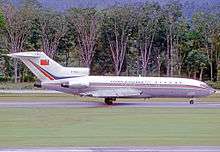
With a fleet of two PBY Amphibians, China Airlines was established on 16 December 1959,[4] with its shares completely held by the Taiwan government. It was founded by a retired air force officer and initially concentrated on charter flights. During the 1960s, China Airlines was able to establish its first scheduled routes. In October 1962, a flight from Taipei to Hualien became the airline's first domestic service.[8] Later, with the introduction of Caravelle and Boeing 727-100s, the airlines introduced international flights to South Vietnam, Hong Kong, and Japan. With the airlines' first two Boeing 707 aircraft, trans-Pacific flights to San Francisco via Tokyo were initiated on 2 February 1970. The expansion of the company's 707 fleet also permitted more services in Southeast Asia, Northeast Asia, and North America (via Japan and Hawaii).
Following the standard utilization of the wide-body 747 on the highly profitable Trans Pacific – USA routes, China Airlines introduced its first two 747-100s (ex-Delta Air Lines aircraft) in 1976 and immediately placed it on its Hong Kong-Taipei-Tokyo-Honolulu-Los Angeles route. Shortly thereafter, four brand new Boeing 747SP (Special Performance) were introduced in 1977. Due to political pressure, Japan ended its diplomatic ties with Taiwan in 1972, and all flights between Taiwan and Japan were stopped. The 747SP aircraft made it possible for China Airlines to fly daily nonstop services from Taipei to its North American destinations without stopping over in Japan. It also allowed the airlines to introduce flights to Saudi Arabia and South Africa. In 1979, the airlines switched all operations from the smaller Taipei Songshan Airport to the newly built Chiang Kai-shek International Airport (now Taoyuan International Airport). Following the introduction of 747-200s, the airlines introduced its first European destination, Amsterdam.
%2C_Netherlands_PP1167244363.jpg)
In 1978, Japan allowed China Airlines to return to Tokyo International Airport at Haneda after relocating all other airlines at the New Tokyo International Airport at Narita, leaving China Airlines as the sole international operator at Haneda, which at the time was an exclusive domestic facility. The premise being that air carriers from the PRC and Taiwan were prevented crossing paths at any Japanese airports. Thus CAL's Osaka service, due to the city's only airport at Itami, would not be reinstated until years later. The crossing of flag-carriers (Taiwan based-airlines and Mainland China PRC based-airlines) occurred almost hourly at then British-controlled Hong Kong's Kaitak International Airport. Adversely, other regional airports such as Bangkok, Singapore and Manila were entirely spared of this indignity imposed on Japan by China.
The next 20 years saw sporadic but far-reaching growth for the company. Later, the airline inaugurated its own round-the-world flight: (Taipei-Anchorage-New York-Amsterdam-Dubai-Taipei). 1993 saw China Airlines listed on the Taiwan Stock Exchange. Later CAL would place one of the largest orders for the newest Boeing 747. The new 747s and an earlier an order with Airbus for over a dozen A300B4 wide body regional jets allowed for addition destination growth.
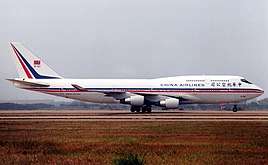
Change of logo and livery (1995–2010)
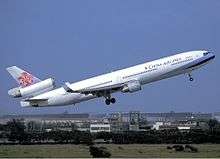
As Republic of China (Taiwan)'s flag carrier, China Airlines has been affected by disputes over the political status of Republic of China (Taiwan), and under pressure from the Communist Party of China, was barred from flying into a number of countries maintaining diplomatic relations with the People's Republic of China ("China"). As a result, in the mid-1990s, China Airlines subsidiary Mandarin Airlines took over some of its Sydney and Vancouver international routes. Partly as a way to avoid the international controversy, in 1995 China Airlines unveiled its "plum blossom" logo,[8] replacing the national flag, which had previously appeared on the tail fins (empennage), and the aircraft livery from the red-white-blue national colors on the fuselage of its aircraft.[9] The plum blossom (Prunus mume) is Taiwan's National Flower.
Throughout the 1990s, the airline employed many ex-ROC Air Force pilots. Due to the company's poor safety record in the 1990s, China Airlines began to change its pilot recruitment practices and the company began to actively recruit civilian-trained pilots with proven track records. In addition, the company began recruiting university graduates as trainees in its own pilot training program. The company also modified its maintenance and operational procedures. These decisions were instrumental in the company's improved safety record, culminating in the company's recognition by the IATA Operational Safety Audit (IOSA).[10]
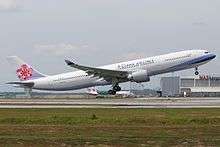
During the 1990s and early 2000s, China Airlines placed orders for various airliners including the Airbus A330, Airbus A340, Boeing 737-800, and the Boeing 747-400 (Both the passenger and freighter version).
Due to improving cross-strait relations, the first cross-strait charter flights between Taiwan and China were introduced in 2003, with China Airlines' flight 585, operated by a Boeing 747–400, being the first Taiwanese flight to legally land in China. (The aircraft took off from Taoyuan Airport, stopped over at Hong Kong Airport, and landed at Shanghai Pudong Airport.) In 2005, the first nonstop cross-strait charter flights were initiated, with China Airlines' flight 581 (Taoyuan Airport to Beijing Capital Airport) being the first flight of the program to depart from Taiwan. In 2008, the first regular weekend charter flights between Taiwan and China started operating, with daily charter flights introduced later in the year. In 2009, regularly scheduled cross-strait flights were finally introduced.
Joining SkyTeam and "NexGen" Plan (2010–present)
China Airlines signed an agreement to begin the process of joining the SkyTeam airline alliance on 14 September 2010[11] and officially became a full member on 28 September 2011.[12] This was marked by an update to the logo of the airline and the typeface in which "China Airlines" is printed. The carrier was the first Taiwanese airline to join an airline alliance.
In December 2013, China Airlines announced its new joint venture with Singaporean low cost carrier Tigerair Holdings (now defunct and replaced by Budget Aviation Holdings) to establish Tigerair Taiwan. The new airline flew its inaugural flight to Singapore on 26 September 2014 and became the first, and currently only, Taiwanese low-cost carrier. Tigerair Holdings previously held 10 percent of the shares. As disputes unfolded surrounding the partnership, China Airlines Group re-negotiated with Tigerair Holdings and has now taken full ownership of Tigerair Taiwan.[7][13]
.jpg)
In March 2014, China Airlines announced the launch of its "NexGen (Next Generation)" plan to complement the first China Airlines Boeing 777-300ER delivery. The plan, designed to refresh the brand image of the carrier, includes product innovations, new uniforms, and fleet replacements. Through cooperating with designers from the Greater China region, the carrier hopes to introduce unique product offerings that can showcase the beauty of the Orient and cultural creativity of Taiwan.[14]
The first phase of the plan has rolled out following the delivery of the first 777 delivery, renovation of Dynasty Lounge at Taiwan Taoyuan International Airport Terminal 1, and debut of new William Chang-designed uniforms.[15] In September 2016, the airline received its first Airbus A350-900XWB, featuring a second version of NexGen China Airlines cabin design. In June 2017, the final Airbus A340-300 of the carrier was sent to Victorville for retirement. Future phases of the plan includes the retirement of the Boeing 747-400, announcement of new narrow-body and regional wide-body orders. Additionally, following the retirement of 747s from long-haul routes, China Airlines has terminated First Class services; First Class seats are now sold as Business Class.[14][16]
Focus has also been put on tapping the maintenance, repair and overhaul (MRO) market. In January 2015, China Airlines established Taiwan Aircraft Maintenance & Engineering Co. (TAMECO), an airline MRO company focusing on Boeing 737, 777, and Airbus A320, A330/A340, and A350XWB families fuselage maintenance. For the project, Airbus is providing a wide range of support, one of which is inviting China Airlines to join the Airbus MRO Alliance (AMA), alongside AAR Corp, Aeroman, Sabena technics, Etihad Airways Engineering, and GAMECO.[17] Moreover, a joint-venture agreement has been signed with Tulsa-based Nordam, specializing in nacelle, thrust reversers, and composite materials, to establish the only Nordam repair center in Asia.[18][19] The first TAMECO hangar, to be completed in March 2019, will be able to accommodate 2 777/A350 and 3 737/A320 at the same time.[20]
Labor-management relations have become increasingly tense over recent years. On 25 June 2016, the Taoyuan Flight Attendants Union, representing some 2500 cabin crew from China Airlines, staged the first strike in Taiwanese aviation history. A total of 122 China Airlines-passenger flights from Taoyuan International Airport and Taipei Songshan Airport were cancelled as a result. The strike ended within a day following government intervention, replacement of top officials, and management-representatives conditionally agreeing to all seven demands from the union.[21] Though the strike has ended, to this day, disputes are still on-going.[22]
Headquarters

China Airlines has its headquarters, CAL Park (Chinese: 華航園區; pinyin: Huáháng Yuánqū[23]), on the grounds of Taiwan Taoyuan International Airport in Dayuan Township, Taoyuan County. CAL Park, located at the airport entrance, forms a straight line with Terminal 1, Terminal 2, and the future Terminal 3.[24]
Previously China Airlines had its headquarters and facilities on the east side of Taipei Songshan Airport, in the China Airlines Building on Nanjing E. Road, and at Taiwan Taoyuan International Airport.[25] The functions were consolidated following the completion of CAL Park. The Taipei Branch Office of the airline remains at the China Airlines Building in downtown Taipei.[26]
Branding
Livery and uniforms
.jpg)
Prior to introducing the current plum blossom livery in 1995, the livery of China Airlines featured the flag of Taiwan on the tail due to commercial and political reasons.[9]
In 2011, after joining Skyteam, the carrier made alterations to its logo as part of refreshing the brand image. A new font was chosen for the company name and a new approach was taken for the appearance of the plum blossom trademark.[27]
China Airlines has had many uniforms since its establishment in 1959. The current uniform was designed by Hong Kong-based costume designer William Chang and introduced in 2015 to celebrate the carrier entering a "NexGen" Next Generation Era.[15]
Marketing slogans
China Airlines has used different slogans throughout its operational history. In 2006, the current slogan was introduced to complement the new uniforms and to celebrate the 47th anniversary. China Airlines' slogans have been as follows:
- We treasure every encounter (1987–1995)
- We blossom everyday (1995–2006)
- Journey with a caring smile (2006–present)
Destinations
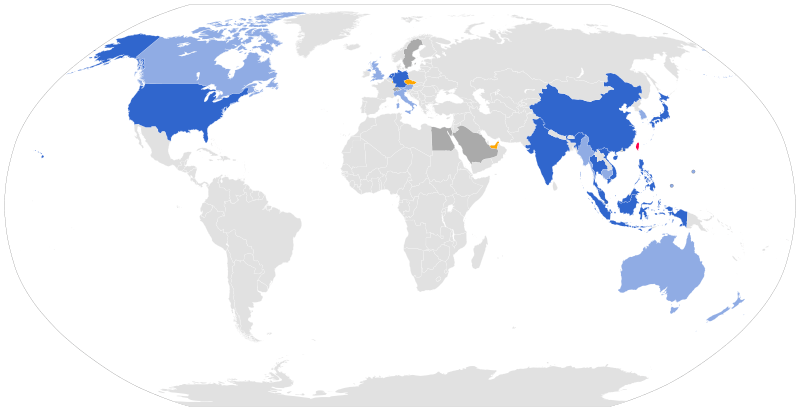
China Airlines currently operates over 1,400 flights weekly (including pure cargo flights) to 118 airports in 115 cities on four continents (excluding codeshare; brackets indicate future destinations). Japan is the most important market of the carrier, with over 180 flights weekly from multiple points in Taiwan to 14 Japanese destinations.[28]
China Airlines has its largest hub at Taiwan Taoyuan International Airport, which is the largest airport in Taiwan and is located near the national capital of Taipei. China Airlines operate out of both Terminal 1 and 2 at the airport. Operations to Europe, India, Korea, Hong Kong and Southeast Asia are located at Terminal 1 while those to China, Japan, North America and Oceania are located at Terminal 2. Additionally, China Airlines and its domestic subsidiary Mandarin Airlines operate numerous flights out of Kaohsiung International Airport and Taipei Songshan Airport, the downtown airport of Taipei. International flights from Songshan Airport to three Northeast Asian downtown airports, namely Tokyo-Haneda, Seoul-Gimpo and Shanghai-Hongqiao, have important significance to the carrier as the routes form a Northeast Asia Golden Flight Circle.[29]
The expansion of China Airlines international presence has long been limited by the political status of Taiwan. Flights to Mainland China were not permitted until 2003, when the carrier's Chinese New Year charter flight 585 from Taipei-Taoyuan to Shanghai-Pudong via Hong Kong made China Airlines the first Taiwanese carrier to legally land in Chinese mainland and the first carrier to legally fly between the two areas after their split during the civil war.[30] The carrier operated occasional cross-strait charter flights for another few years until 2008, when regular charters flights started. In 2009, a new air service agreement allowed China Airlines to start regularly scheduled flights to the Mainland.[31] Since then, China has quickly become the second largest market for China Airlines, with over 130 flights to 33 destinations across the Mainland.[32]
Route plans
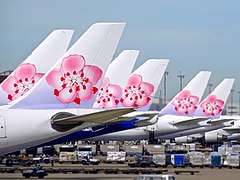
Over the period between 2011 and 2015, China Airlines focused on strengthening its regional network; starting 2015 until 2020, the carrier is strengthening and expanding its European, North American and Oceanian network with the new long-haul fleet.[33] After upgrading all its European routes to nonstop services, in late 2017, the carrier launched four weekly services to London Gatwick Airport.[34] In France, as China Airlines does not have rights to operate flights to Paris, the airline cooperated with Skyteam-partner Air France to launch nonstop flights to the French capital on Air France metal in April 2018. China Airlines sells 40% of the seats on the flight.[35] In America, daily flights were launched between Taipei and Ontario International Airport in Greater Los Angeles in March 2018 .[36] Additionally, the carrier has expressed interests in launching European destinations such as Barcelona, Madrid, Milan, and Prague;[37] in North America, Atlanta, Boston, Chicago, Seattle, and Toronto.[38][39][40][41]
Regarding its regional network, China Airlines is actively supporting the "New Southward Policy" of the Taiwanese government by adding frequencies to Southeast Asia. On the other hand, Mainland routes are being downsized due to tense cross-strait relations.[42]
Codeshare agreements
China Airlines codeshares with the following airlines:[43][44]
- Air Europa[45]
- Air France[46]
- Alitalia
- Bangkok Airways
- British Airways
- China Eastern Airlines
- China Southern Airlines
- Czech Airlines
- Delta Air Lines
- Garuda Indonesia
- Hawaiian Airlines
- Japan Airlines
- KLM
- Korean Air
- Malaysia Airlines[47]
- Philippine Airlines
- Qantas[48]
- Shanghai Airlines
- Vietnam Airlines
- WestJet
- XiamenAir
Deutsche Bahn (DB) is the only non-airline codeshare partner of China Airlines. The CI code is placed on seven Frankfurt-initiating DB routes, including those to Cologne, Düsseldorf, Hamburg, Hanover, Munich, Nuremberg, and Stuttgart.[49] Additionally, China Airlines is planning on codesharing with British Airways. Initial agreements have been struck to cooperate from Taipei-Taoyuan to London-Gatwick and beyond.[50]
Fleet
Current fleet
As of October 2018 the China Airlines fleet consists of the following aircraft:[51][52]
| Aircraft | In service | Orders | Passengers | Notes | ||||
|---|---|---|---|---|---|---|---|---|
| C | W | S | Y | Total | ||||
| Airbus A330-300 | 24 | — | 36 | — | — | 277 | 313 | |
| 30 | 277 | 307 | ||||||
| Airbus A350-900 | 14[53] | — | 32 | 31 | 36 | 207 | 306 | |
| Boeing 737-800 | 18 | — | 8 | — | — | 150 | 158 | |
| 153 | 161 | |||||||
| Boeing 747-400 | 4 | — | 12 | 49 | — | 314 | 375 | |
| Boeing 777-300ER | 10 | — | 40 | 62 | 30 | 226 | 358 | |
| China Airlines cargo fleet | ||||||||
| Boeing 747-400F | 18 | — | ||||||
| Total | 88 | — | ||||||
Retired fleet
| Aircraft | Fleet | Introduced | Retired | Notes |
|---|---|---|---|---|
| Airbus A300B4-200 | 6 | 1985 | 2001 | |
| Airbus A300-600R | 14 | 1987 | 2008 | B-1814 crashed as Flight 676. B-1816 crashed as Flight 140. |
| Airbus A320-200 | 2 | 1991 | 1997 | Leased |
| Airbus A340-300 | 6 | 2001 | 2017 | One aircraft was sold to Kingdom of Swaziland. Two aircraft are currently stored. |
| Boeing 707 | 6 | 1969 | 1985 | |
| Boeing 727 | 4 | 1967 | 1982 | |
| Boeing 737-200 | 7 | 1976 | 1997 | |
| Boeing 737-400 | 6 | 1996 | 1999 | |
| Boeing 747-100 | 2 | 1976 | 1984 | |
| Boeing 747-200 | 19 | 1979 | 2002 | B-18255 crashed as Flight 611. Three aircraft converted into freighters. |
| Boeing 747-200F | 3 | 1980 | 2003 | B-198 crashed as Flight 358. |
| Boeing 747-200SF | 7 | 1992 | 2002 | Four aircraft were leased from Atlas Air |
| Boeing 747-400 | 14 | 1991 | – | Six aircraft are currently stored. Two were converted to Boeing Dreamlifters B-165 was written off at Kai Tak Airport, the first Boeing 747-400 accident. |
| Boeing 747-400F | 5 | 2000 | 2012 | Three aircraft are currently stored. Two aircraft were leased from Atlas Air. |
| Boeing 747SP | 4 | 1977 | 1998 | |
| Boeing 767-200 | 2 | 1983 | 1989 | Disposed to Air New Zealand |
| McDonnell Douglas MD-11 | 5 | 1992 | 2002 | B-150 crashed as Flight 642. |
| PBY Catalina | 2 | 1959 | 1966 | China Airlines' first aircraft, from ROC Air Force |
.jpg) China Airlines Airbus A300-B4
China Airlines Airbus A300-B4.jpg) China Airlines Airbus A300-600R
China Airlines Airbus A300-600R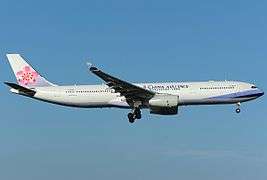 China Airlines Airbus A330-300 with Rolls Royce engines (leased from Virgin Atlantic)
China Airlines Airbus A330-300 with Rolls Royce engines (leased from Virgin Atlantic)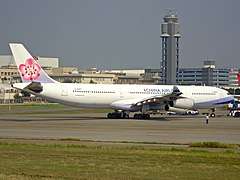 China Airlines Airbus A340-300
China Airlines Airbus A340-300_China_A-l_HKG_27OCT81_(6051901741).jpg) China Airlines Boeing 707
China Airlines Boeing 707 China Airlines Boeing 747-200F
China Airlines Boeing 747-200F China Airlines Boeing 747-SP
China Airlines Boeing 747-SP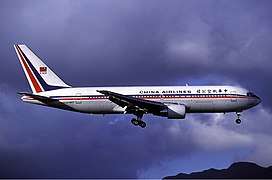 China Airlines Boeing 767-200
China Airlines Boeing 767-200_(4528145712).jpg) China Airlines Boeing 747-409 (B-162) in Striped Livery.
China Airlines Boeing 747-409 (B-162) in Striped Livery.
Renewal plans
.jpg)
In 2008, China Airlines firmed up an order for 14 Airbus A350-900 aircraft along with another 6 options.[54] In 2012, an order for 6 Boeing 777-300ER and a lease agreement with GECAS for 4 more of the type were confirmed. Both the Airbus A350-900 and Boeing 777-300ER replaced the aging Airbus A340-300 and Boeing 747-400 on intercontinental routes. Deliveries of the Boeing 777-300ER started in 2014 and were completed in 2016. The first Airbus A350-900 was delivered in 2016.[38] In July 2017, Airbus delivered its 100th A350 to China Airlines.[55]
China Airlines has options for another 6 A350s. Decision to switch the options to firm orders will be based upon the performance of the aircraft on European nonstop routes.[56] The airline has taken a cautious attitude towards ordering the largest A350-1000 variant due to large capacity of the type.[57]
Regarding the narrow-body fleet, the airline is planning on ordering around 20 narrow-body aircraft for itself and subsidiary Mandarin Airlines by July 2018.[58] Types in consideration include the Boeing 737MAX and Airbus A320neo. The much-delayed order was originally planned to include around 50 aircraft and an order for Tigerair Taiwan when it was first announced in 2015. However, due to drastic market changes, including the decline of Mainland visitors and oversupply in the Japanese markets, the type and size of the new narrow-body fleet is being reconsidered. For the short-term, the airline has chosen to lease new Boeing 737-800s.[59][60]
Replacement plans are also underway for the regional wide-body fleet of Airbus A330-300. In 2017, China Airlines announced that a decision for A330 replacement would be decided within two years.[61] Previously in 2016, a retrofit program was announced to upgrade the in-flight products on the A330. The plan was suspended indefinitely in favor of ordering and leasing new aircraft.[62]
Retirement plans
In June 2017, China Airlines completed the retirement of its entire Airbus A340-300 fleet and all Boeing 747-400 delivered before 2004. It has also phased out most Boeing 737-800 delivered before 2014. The retired A340-300 and Boeing 747-400 are either stored at the aircraft boneyard at Victorville Airport or sold. All stored passenger aircraft are to be sold eventually.[33][63][64][65] Regarding the newer Boeing 747-400 passenger fleet with the General Electric CF6 engines, they will be kept to operate high demand cross-strait and regional flights.[66][67]
Cargo fleet plans
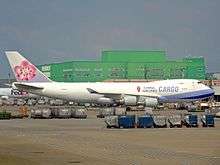
China Airlines Cargo, the freight division of China Airlines, currently operates a fleet of 18 freighters to 33 destinations across Asia, Europe and North America, in addition to utilising the cargo space on passenger aircraft. Over the past few years, it has been suffering from falling freight demands and has stored three Boeing 747-400Fs at Victorville Airport.[68]
Special liveries
The first China Airlines special livery, the "Taiwan Touch Your Heart" tourism-promotional livery, was introduced in 2003. The project was a collaboration between the carrier and the Tourism Bureau of Taiwan. However, the plane was painted back to the normal livery before it left the hangar.[69] Currently, China Airlines has a total of 7 special livery aircraft in service.
Aircraft manufacturer co-branded liveries
China Airlines has a history of partnering with aircraft manufacturers to introduce special liveries. The first co-branded livery aircraft was a Boeing 747-400, which was delivered in 2004 carrying the combined livery-design of Boeing and the airline; the aircraft was painted back to China Airlines corporate colors in 2012. The second co-branded livery was painted on a Boeing 777-300ER delivered in May 2016.[70] The third co-branded livery aircraft, first with Airbus, was painted on an Airbus A350-900. The design interweaves the China Airlines brand colors with the Airbus carbon fiber pattern.[71]
Plane currently carrying hybrid liveries:
- B-18007 (Boeing 777-300ER) –- world's first co-branded Boeing 777[71]
- B-18918 (Airbus A350-900) -- first aircraft in the world to use an Airbus co-branded livery.[70]
Plane once carrying a hybrid livery:
- B-18210 (Boeing 747-400) – nicknamed 'Blue Whale'; first aircraft in the world to use Boeing’s co-branded livery on the 747-400[70]
"Flying Ambassador of Taiwan” series
In 2016, China Airlines announced that the Airbus A350-900 fleet will have a naming theme that combines endemic birds and unique features of Taiwan. The first two A350s were named Mikado pheasant and Taiwan blue magpie by the airline. The names of the remaining 12 aircraft were selected by the Taiwanese public online from a total of 24 choices.
Planes currently part of the series:
- B-18901 (Airbus A350-900) – named and decorated after Mikado pheasant[72]
- B-18908 (Airbus A350-900) – named and decorated after Taiwan blue magpie[72][73]
Skyteam alliance livery
China Airlines has two aircraft painted in the Skyteam alliance livery:
- B-18211 (Boeing 747-400) – currently the only Boeing 747 wearing the Skyteam livery
- B-18311 (Airbus A330-300) – previously wearing the "Sweet" Fruit livery
Plane once part of the series:
- B-18206 (Boeing 747-400) – first Boeing 747 to wear the Skyteam livery
Taiwanese culture and creativity series
In 2013, China Airlines revealed plans to start a series of Taiwan-themed special livery aircraft. The carrier collaborated with Taiwanese artists, cultural workers, and the Tourism Bureau to design the special liveries.[74]
Plane currently part of the series:
- B-18361 (Airbus A330-300) – "Cloud Gate Dance Theatre of Taiwan" livery, in collaboration with Cloud Gate Dance Theatre[74]
Planes once part of the series:
- B-18203 (Boeing 747-400) – Love & Hug livery, in collaboration with illustrator Jimmy Liao[74]
- B-18358 (Airbus A330-300) – "Masalu! Taiwan" livery, in collaboration with Paiwan artist Sakuliu Pavavalung and the Council of Indigenous Peoples[74]
Other existing special liveries
Other retired special liveries
- B-18209 (Boeing 747-400) – "Taiwan Touch Your Heart" livery, in collaboration with the Tourism Bureau
- B-18305 (Airbus A330-300) – butterfly orchid livery, in collaboration with the Council of Agriculture
- B-18311 (Airbus A330-300) – "Sweet" Fruit livery, in collaboration with the Council of Agriculture; currently wearing Skyteam livery.
- B-18355 (Airbus A330-300) – "Welcome to Taiwan" livery, in collaboration with the Tourism Bureau; repainted to standard livery
- B-18610 (Boeing 737–800) – Lavender livery, commemorating launch of Sapporo flights
- B-18806 (Airbus A340-300) – "The Official Airline for Climate Monitoring" livery for the Pacific Greenhouse Gases Measurement (PGGM) Project; aircraft previously part of "50th Anniversary" series; aircraft retired
50th Anniversary series
In 2009, China Airlines decorated one plane of each of its plane types with the 50th anniversary logo. All planes of the series now wear the regular corporate livery or another special livery.
Planes once part of the series:
- B-18208 (Boeing 747-400)
- B-18312 (Airbus A330-300)
- B-18606 (Boeing 737–800)
- B-18725 (Boeing 747-400F)
- B-18806 (Airbus A340-300) – later wore the "Official Airline for Climate Monitoring" livery until its retirement
 'Blue Whale' 747 B-18210 in the hangars
'Blue Whale' 747 B-18210 in the hangars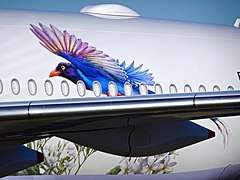 "Taiwan Blue Magpie" A350 B-18908 close-up
"Taiwan Blue Magpie" A350 B-18908 close-up Skyteam A330 B-18311 taking off from Bangkok
Skyteam A330 B-18311 taking off from Bangkok- 'Welcome To Taiwan' A330 B-18355 close-up
Cabin classes
Business Class
Business Class, formerly known as Dynasty Class, is offered on all China Airlines aircraft.
Premium Business Class
Premium Business Class is available on the Boeing 777-300ERs and Airbus A350-900.[38] The seats are configured in a 1-2-1 layout, offering every passenger direct aisle access. The seat is 78 inch long in full flat mode. Each seat features natural woodgrain table, adjustable reading lights, multiple storage bins, AC and USB sockets and an 18-inch multiple-touch screen with touchscreen-control. Turndown service is offered by cabin crew upon request while a self-service galley bar, named as Sky Lounge, offers snacks, instant noodles, drinks, and books for passengers during in-flight.[38][76]
Former First Class seats
China Airlines has terminated First Class services since 1 July 2015. However, it still offers the hardware product on the Boeing 747 aircraft and markets the seats as Business Class ones. There are 12 flat-bed First Class seats located in each of the three-class Boeing 747s nose sections. Each seat features a 15.1-inch personal screen with Audio and Video On Demand (AVOD), USB port, universal power outlet, and noise cancelling headphone. Turndown service is offered by cabin crew upon request.[77]
Recliner and angle-flat seats
On the long haul Airbus A330-300s, there are 30 shell seats with 63" of pitch and 166° of recline; on the medium haul A330s, there are 36 shell seats with 52" of pitch and 140° of recline. All Business Class seats on the Airbus fleet have in-seat power and personal television screens.
Boeing 747 aircraft equipped with First Class flatbed-seats have 49 Business Class recliner seats. All seats offer 60" of pitch, in-seat power, 10.4" IFE displays and have 140° of recline. Boeing 737-800 aircraft are equipped with 8 recliners styles seats with 40" of pitch.
Premium Economy Class
Premium Economy Class is offered on the Boeing 777-300ER and Airbus A350-900XWB. The class features fixed-back seats, 12.1-inch multiple-touch screens, USB ports, universal power outlets, footrests, leg-rests, and tables with adjustable tablet holders. Passengers traveling in Premium Economy Class will receive complimentary amenity kits, slippers and inflatable neck-rests. The seat pitch is approximately 39 inch.[76]
Economy Class
Economy Class on all aircraft features 31–32" of pitch and, except on Boeing 737 aircraft, IFE screens ranging from 6.5" to 11.1" inch size.
China Airlines previously sold the Family Couch product on long haul flights operated by the Boeing 777-300ER and the Airbus A350-900XWB.[38] It was a set of three Economy class seats, in the first 10 rows on the right of the Economy Class cabin on the 777 and first 6 rows on both right and left of the Economy Class cabin on the A350, that could be easily converted into a large surface area. By booking three adjacent Family Couch seats on long-haul flights, passengers could lie flat on their backs.[38][76][78] However, due to low popularity, China Airlines has stopped selling the product as of June 2018. Seats capable of becoming Family Couch seats will now have leg-rests locked.[79]
In-flight services
Meal services
Food and beverages served on flights from Taipei are provided by China Pacific Catering Services (CPCS) facilities in Taipei. China Airlines offers a variety of meals on intercontinental routes, depending on seat class, destination and flight length. Western and Eastern menu selections are typically offered, including seasonal menu selections varied by destination. Special meal offerings can be requested in each class during booking, including children's, religious, vegetarian, and other meals. Meals from famous Taiwanese restaurants or hotels are offered, mostly to First and Business Class passengers.
China Airlines also offers refreshments (also known as light meals) or snack boxes on all of their international flights. Mixed nuts are offered to customers in all classes before flight while pre-flight drinks are served exclusively to First and Business Class passengers.
Self-Service Galley Bar
The Boeing 777-300ER and Airbus A350-900 of China Airlines features a galley bar, Sky Lounge, for Premium Business Class passengers to serve themselves with coffee, tea, alcoholic beverages, cup noodles, or snacks. The bar area also features social areas, located next to the exits, and books selected by Eslite Bookstore.[76]
In-flight entertainment
Fantasy Sky, the in-flight entertainment system of China Airlines, is available on all aircraft types excluding the Boeing 737–800. The system comes in three languages: Traditional Chinese, English and Japanese. Over 100 movies are offered in addition to television shows, songs, and video games. Other functions include exterior camera views, company information, and connecting flight data (available prior to landing). Furthermore, on the Boeing 777-300ER, "Fantasy Sky" features Duty Free catalogues, E-Books, surveys and chatrooms.[76]
Regarding personal electronic devices, China Airlines, in accordance with governmental regulations, allows passengers to use electronics, storable in the seat pocket and under flight mode, throughout the journey. Digital devices heavier than 1 kg can only be used above 10,000 feet. Furthermore, after landing and during long delays, data roaming will be allowed under the captain's permission.[80]
In-flight connectivity (Wi-Fi)
In-flight Wi-Fi, utilizing the T-Mobile systems and Ku band satellite disks, is available on the Boeing 777-300ER and Airbus A350-900 once the plane reaches cruising altitude. Passengers can enjoy internet connection by paying through the system. There are also free services such as news articles and weather information. Phone calls and video chat are not permitted on the system.[38][76]
In-flight magazines

China Airlines publishes three in-flight magazines for its passengers: DYNASTY, Fantasy Sky, and Sky Boutique.
DYNASTY, the China Airlines magazine, has articles in English, Chinese, and Japanese. The articles feature local and international events, descriptive culture, social introductions, personal interviews, in-flight entertainment instructions, and China Airlines news.
Fantasy Sky, China Airlines' in-flight entertainment guide, provides information on the movies, videos, music, and radio channels offered.
Sky Boutique is China Airlines' duty-free catalog.
Dynasty Flyer
Dynasty Flyer is China Airlines' frequent flyer program. There are four tiers where three elite tiers are Gold, Emerald, and Paragon. Members can qualify for these elite tiers by earning enough air miles and/or segments within 12 calendar months. Elite members have more privileges such as access to the VIP Lounge, a higher checked baggage allowance, and being able to upgrade their ticket to a different cabin.[81]
Greater China Connection
In January 2013, Skyteam-members China Airlines, China Eastern Airlines, China Southern Airlines, and Xiamen Airlines announced plans to establish Greater China Connection. The partnership ensures that members flying the four airlines can enjoy matched benefits and freely change flights to any Greater China Connection partner-flights.[82]
Dynasty Lounges
China Airlines' airline lounges are branded as "Dynasty Lounge". There are a total of 9 China Airlines lounges (including 1 Mandarin Airlines lounge in Taichung) at 7 different airports. Lounge services at other China Airlines destinations are offered by Skyteam, partner airlines, or local operators. Dynasty Lounge is available to Business Class passengers and Dynasty Flyer Gold, Emerald, and Paragon card holders. Two-section lounges include an Exclusive Area, for Dynasty Flyer Emerald and Paragon card holders, and a Business Class Area, for Business Class passengers and Dynasty Flyer Gold card holders.
Dynasty Lounge features vary by location. Services typically include meals, refreshments, free Wi-Fi access, computers, televisions, publications, shower facilities, and breast-feeding rooms. Sleeping quarters and tea bars are featured at the newly renovated Taiwan Taoyuan International Airport Terminal 1 lounge, which was designed by Taiwanese architect Ray Chen.[83]
Location of Dynasty Lounges:[84]
- Taipei Taoyuan International Terminal 1
- Taiwan Taoyuan International Airport Terminal 2 (near Gate D4; closed for renovation until Sep 2018[85])
- Taiwan Taoyuan International Airport Terminal 2 (previously branded as Dynasty Supreme Lounge)
- Kaohsiung International Airport
- Kuala Lumpur International Airport
- Bangkok Suvarnabhumi International Airport
- Tokyo Narita International Airport Terminal 2
- Honolulu International Airport
- San Francisco International Airport
Skyteam Lounge Hong Kong
At Hong Kong International Airport Terminal 1, China Airlines utilises the Skyteam alliance lounge, in which the carrier, alliance partner China Eastern Airlines, and Plaza Premium Lounge lead the designing, management, and operations. The 1,038 square meters lounge is located near Gate 15 and provides a total of 230 seats. Facilities include VIP room, lounge area, dining area with a hot and cold buffet of international cuisine, bar, business centre, TV room, yoga room, and shower rooms. Regarding connectivity, there are work stations, charging points for electronic devices, complimentary Wi-Fi access.[86]
Private bus services in the United States
In the United States, China Airlines operates private bus services in selected cities to transport customers between their residing location and the airport.[87]
In Greater New York, the airline operates a bus to John F. Kennedy International Airport from Fort Lee, Parsippany-Troy Hills, and Edison in northern New Jersey, and several points in Greater Philadelphia, including Cherry Hill, New Jersey, North Philadelphia, and South Philadelphia. In Los Angeles, a bus transports customers between Los Angeles International Airport, Monterey Park and Rowland Heights.[88]
Previously, the airline operated buses for travelers in San Francisco, Houston and Abu Dhabi.[87] The San Francisco buses transported customers to/from Milpitas and Cupertino.[89] The Houston bus service served Sugar Land and Southwest Houston Chinatown.[90]
Pacific Greenhouse Gases Measurement (PGGM) Project
Since 2012, China Airlines has been participating in the Pacific Greenhouse Gases Measurement (PGGM) Project, led by the Environmental Protection Administration, Ministry of Science and Technology, and National Central University. As part of the collaboration, China Airlines installed "In-service Aircraft for a Global Observing System (IAGOS)" on three aircraft: B-18806 (Airbus A340-300) in June 2012, B-18317 (Airbus A330-300) in July 2016, and B-18316 (Airbus A330-300) in July 2017. B-18806 also wore "The Official Airline for Climate Monitoring" special livery. Between July 2012 and September 2017, the PGGM fleet collected greenhouse gases-data from a total of 4682 flights. In May 2017, B-18806 was retired. B-18316 and B-18317 are expected to continue collecting data until 2027.[91][92]
Subsidiaries and associates
China Airlines has diversified into related industries and sectors, including ground handling, aviation engineering, and inflight catering.
Companies with a major China Airlines Group stake include:[4]
| Company | Type | Principal activities | Incorporated in | Group's equity shareholding |
|---|---|---|---|---|
| Cal-Asia Investment Inc. | Subsidiary | Holding company | British Virgin Islands | 100% |
| CAL Park | Subsidiary | Headquarters | Taiwan | 100% |
| China Aircraft Services Limited[93] | Joint Venture | Maintenance Company | Hong Kong | 20% |
| China Pacific Catering Services Limited | Subsidiary | Catering services | Taiwan | 51% |
| China Pacific Laundry Services Limited | Subsidiary | Laundry | Taiwan | 55% |
| Dynasty Holidays | Subsidiary | Travel agency | Taiwan | 51% |
| Global Sky Express Limited | Joint Venture | Cargo loading | Taiwan | 25% |
| Hwa Hsia Company Limited | Subsidiary | Laundry | Taiwan | 100% |
| Mandarin Airlines | Subsidiary | Airline | Taiwan | 93.99% |
| Taiwan Air Cargo Terminals Limited | Subsidiary | Cargo loading | Taiwan | 54% |
| Taiwan Aircraft Maintenance & Engineering Co. (TAMECO) | Subsidiary | MRO company | Taiwan | 100% |
| Taoyuan International Airport Services Limited | Subsidiary | Ground handling | Taiwan | 49% |
| Tigerair Taiwan | Subsidiary | Low-cost carrier | Taiwan | 100%[94] |
Incidents and accidents
Between 1994 and 2002, China Airlines suffered four fatal accidents,[95] three of which each resulted in more than 200 deaths. The accidents contributed to the airline having a poor reputation for safety, partly blamed on an air force-influenced pilot culture.[96] Since then, the airline's safety record has seen an improvement. In 2007, in an article published after the explosion of Flight 120, The Wall Street Journal quoted analysts as saying the airline has had "a marked improvement in safety and operational performance since 2002", with the mid-air disintegration of Flight 611 being "a catalyst for an overhaul" in its safety practices.[95]
- On 2 January 1969, Flight 227, a Douglas C-47A, struck the side of Mount Dawu (大武山, elevation 3090 m), Taiwan after encountering turbulence and a downdraft. The aircraft was operating a domestic scheduled passenger flight from Taitung Airport to Kaohsiung International Airport. All 24 passengers and crew were killed.[97]
- On 12 August 1970, Flight 206, a NAMC YS-11A, struck a ridge in thick fog while on approach to Taipei, killing 14 of 31 on board.[98]
- On 20 November 1971, Flight 825, a Caravelle III aircraft, blew up after a bomb on it exploded, causing the deaths of 25 people over the Penghu Islands.[99]
- On 26 March 1975, Douglas C-47A B-1553 crashed at Kompong Som following a mid-air collision with a Cessna L-19 Bird Dog.[100]
- On 11 September 1979, Boeing 707-320Cregistration B-1834, crashed off Chiang Kai-shek International Airport shortly after takeoff during a training flight, killing all six crew on board.[101]
- On 27 February 1980, Flight 811, a CAL Boeing 707-300C, registration B-1826, crashed short of the runway at Manila International Airport, killing two of 135 on board.[102] The same route with the same flight number will be the scene of an assassination of a Filipino politician three years later.
- On 21 August 1983, an Airbus A-300 from Taipei, landed in Manila International Airport. Benigno Aquino Jr. the former senator in Philippines was assassinated after being escorted from the plane. Coincidentally, this is the second incident of China Airlines involving the flight number 811.
- On 19 February 1985, Flight 006, a Boeing 747SP, performed an uncontrolled descent over the Pacific Ocean resulting in substantial damage to the aircraft.[103]
- On 16 February 1986, Flight 2265, a Boeing 737–200, crashed 12 mi off Makung, Penghu, killing 13. During landing, a nosewheel tire blew. The crew performed a go-around during which the aircraft crashed; the wreckage was found on March 10 in 190 feet of water.[104]
- On 3 May 1986, Flight 334, a Boeing 747-200F, was hijacked by its pilot, who landed the plane in Guangzhou, China where he defected. The ROC government sent a delegation to discuss with their mainland counterpart regarding the return of the plane and two remaining crew.[105]
- On 26 October 1989, Flight 204, a Boeing 737–200, struck a mountain near Hualien, Taiwan after the crew used the climbout procedure of the incorrect runway, causing the aircraft to make a wrong turn. All 54 passengers and crew aboard were killed.[106]
- On 29 December 1991, Flight 358, a Boeing 747-200F (the same aircraft that was involved in the Flight 334 hijacking), hit a hillside near Wanli, Taiwan after separation of its No.3 & 4 engines, killing all five crew on board.[107]
- On 4 November 1993, Flight 605, a brand new Boeing 747–400, overran the Kai Tak Airport runway 13 while landing during a typhoon. It had touched down more than 2/3 down the runway and was unable to stop before the end of the runway, finishing up in Hong Kong harbor. All 396 people on board were safely evacuated but the aircraft was written off. The vertical stabilizer was dynamited away due to its interference with Kai Tak's ILS systems.[108]
- On 26 April 1994, Flight 140, an Airbus A300, crashed while landing at Nagoya, Japan due to crew error, killing 264 of 271 on board.[109]
- On 16 February 1998, Flight 676, an Airbus A300, crashed after a failed missed-approach at Chiang Kai-shek International Airport in Taiwan, killing all 196 aboard along with 7 on the ground, including ROC Central Bank chief Hsu Yuan-Dong.[110]
- On 22 August 1999, Flight 642, a McDonnell Douglas MD-11, flipped over while landing at Hong Kong airport during a typhoon. Three people were killed.[111]
- On 25 May 2002, Flight 611, a Boeing 747-200B, broke up in mid-air on the way to Hong Kong International Airport in Hong Kong from Chiang Kai-shek International Airport in Taiwan. All 206 passengers and 19 crew members died. The aircraft was the last 747-200 in China Airlines' passenger fleet. The cause was improper repair after a tailstrike incident in Hong Kong in 1980.[112]
- On 20 August 2007, Flight 120, a Boeing 737–800 inbound from Taipei caught fire shortly after landing at Naha Airport in Okinawa Prefecture, Japan. After stopping on the tarmac, the engine started smoking and burning, and later exploded causing the aircraft to catch fire.[113] A statement from the airline confirmed that all passengers and crew members were safely evacuated, and a ground engineer knocked off his feet by the blast was unhurt.[114] The cause of the explosion has been attributed to a fuel leak caused by a bolt from the right wing slat puncturing the fuel tank.[115][116]
See also
References
- 1 2 華航董事會通過何煖軒、謝世謙人事案. SET News (in Chinese). SET News. Retrieved 24 June 2016.
- 1 2 3 4 5 6
- ↑ "CAL Annual Report 2017" (PDF). China Airlines. China Airlines. Retrieved 14 June 2018.
- 1 2 3 "China Airlines – About Us". www.china-airlines.com. China Airlines. Retrieved 22 December 2016.
- ↑ 國籍航空公司全球航線客貨運概況 (PDF). www.caa.gov.tw. CAA Taiwan. Retrieved 15 July 2014.
- ↑ China Airlines (2015). China Airlines 2015 Annual Report (PDF) (Report). p. 12. Retrieved 22 December 2016.
The company operates 91 flights per week, including 35 transoceanic flights, 6 European flights, and 50 Asian flights.
- 1 2 Shih, Kai-Chin. "LCC War Kicks Off In Taiwan: Tigerair Taiwan and V Air Ready To Take To The Skies". Talkairlines. Retrieved 27 September 2014.
- 1 2 "Company History". China Airlines. Retrieved 22 December 2016.
- 1 2 Murphy, Kevin (1995-08-14). "Taipei Notebook : A Flag-Carrier That Won't". The New York Times. ISSN 0362-4331. Retrieved 2017-05-11.
- ↑ "China Airlines Once Again Passes Rigorous Safety Audit" (Press release). China Airlines. 2009-03-18. Archived from the original on 4 March 2016. Retrieved 22 December 2016.
- ↑ "China Airlines Joins SkyTeam" (Press release). SkyTeam. 14 September 2010. Retrieved 22 December 2016.
- ↑ Wang Shu-fen; Huang, Frances (2010-09-04). "China Airlines to join Sky Team Alliance". Focus Taiwan. Retrieved 2010-12-13.
- ↑ 虎航成華航100%子公司. Liberty Times. Liberty Times. Retrieved 15 December 2017.
- 1 2 Shih, Kai-Chin. "China Airlines "Next Generation Plan" Part I: The New Boeing 777-300ER Cabin". Talkairlines. Talkairlines. Retrieved 11 July 2014.
- 1 2 "China Airlines Debuts William Cheung-Designed Uniforms". talkairlines. talkairlines. Retrieved 13 June 2015.
- ↑ 華航新空巴入列 歐洲線12月全數直飛. UDN (in Chinese). UDN. 30 September 2016. Retrieved 22 December 2016.
- ↑ "Airbus Customer Services launches Airbus MRO Alliance". Airbus. Airbus. Retrieved 13 June 2018.
- ↑ Lee Hsin-Yin. "China Airlines eyeing aircraft maintenance business". Focus Taiwan. CNA. Retrieved 22 December 2016.
- ↑ =新聞專區. 中華航空公司機務組織. Retrieved 15 December 2017.
- ↑ "國內最大!台飛新棚廠上樑 明年正式啟用". CTEE. CTEE. Retrieved 11 June 2018.
- ↑ 空服員罷工 華航2天營損2.8億元. China Times. China Times. Retrieved 25 June 2016.
- ↑ 華航總座謝世謙:飛安不妥協,紀律不打折. CTEE. CTEE. Retrieved 15 December 2017.
- ↑ 「華航園區新建工程」1月31日隆重舉行開工動土典禮 2009年底完工 將成為臺灣桃園國際機場地標. china-airlines.com (in Chinese). Archived from the original on 5 October 2013. Retrieved 22 December 2016.
「華航園區」預定2009年底前完工營運, ...
- ↑ "China Airlines Inaugurates CAL Park at Taoyuan Airport" (Press release). China Airlines. 2010-03-26. Archived from the original on 14 October 2013. Retrieved 22 December 2016.
- ↑ China Airlines. "Investor Relations". Archived from the original on 6 March 2009. Retrieved 22 December 2016.
Address: No.131, Sec. 3, Nanjing E. Rd., Taipei City 104, Taiwan (R.O.C.)
- ↑ "Branch Office". china-airlines.com. Retrieved 22 December 2016.
No. 131, Section 3, Nanjing East Road, Taipei City 104, Taiwan
- ↑ Lee, Cheng Yu (27 August 2011). 華航紅梅改版 潑墨味淡了?. World Journal. World Journal. Archived from the original on 15 July 2014. Retrieved 11 July 2014.
- ↑ 華航高雄九州紅不讓 接力開航熊本福岡. CNA. CNA. Retrieved 26 October 2015.
- ↑ "China Airlines Launches Taipei Songshan-Seoul Gimpo Service on April 30". China Airlines (Press release). China Airlines. 30 April 2012. Archived from the original on 4 March 2016. Retrieved 22 December 2016.
- ↑ "2003年2月,兩岸首次實現春節包機". Huaxia.com. Huaxia.com. Retrieved 24 February 2015.
- ↑ 2009年8月31日起正式啟動兩岸定期航班 [Beginning 31 August 2009, regularly scheduled cross-strait flights will begin]. Taiwan Economic Cultural Office in Atlanta (in Chinese). Taiwan Economic and Cultural Office in Atlanta. Archived from the original on 24 February 2015. Retrieved 22 December 2016.
- ↑ 六月兩岸航線 華航每周130個航班. CRNTT.com. CRNTT.com. Retrieved 10 December 2017.
- 1 2 "China Airlines Annual Report 2014" (PDF). www.china-airlines.com. China Airlines. Archived from the original (PDF) on 23 November 2015. Retrieved 22 December 2016.
- ↑ 13小時!華航直飛倫敦 開航了. UDN News. UDN News. Retrieved 10 December 2017.
- ↑ 睽違20年法航復飛台灣 華航著力深. 經濟日報. 經濟日報. Retrieved 20 May 2018.
- ↑ "China Airlines launches daily Taipei – Ontario service from Mar 2018". Routes Online. AirlineRoute. Retrieved 21 December 2017.
- ↑ 強化直飛效應 華航相中米蘭、布拉格. China Times. China Times. Retrieved 28 September 2017.
- 1 2 3 4 5 6 7 "A350-900XWB Cabin Interiors and Route Plans". talkairlines. talkairlines. Retrieved 27 Oct 2016.
- ↑ 華航董座專訪/華航開源節流 賺錢擺第一. UDN. UDN. Retrieved 1 October 2016.
- ↑ 華航搶攻飛機維修 何煖軒自爆向長榮學習. CNA. CNA.
- ↑ "Taiwan's China Airlines in talks to start Ontario, CA ops". ch-aviation. ch-aviation. Retrieved 5 September 2017.
- ↑ 華航今年獲利 可望飛躍39億. China Times. China Times. Retrieved 13 August 2016.
- ↑ "Profile on China Airlines". CAPA. Centre for Aviation. Archived from the original on 2016-10-30. Retrieved 2016-10-30.
- ↑ http://www.routesonline.com/news/38/airlineroute/269810/china-airlines-malaysia-airlines-proposes-codeshare-service-from-nov-2016/
- ↑ "About Us". China Airlines. 30 September 2017. Retrieved 1 October 2017.
- ↑ "China Airlines fleet".
- ↑ "Airbus A350 Production".
- ↑ "China Airlines, Airbus and Rolls-Royce Sign Purchase Agreement for 20 New A350 Aircraft" (Press release). China Airlines. 22 January 2008. Archived from the original on 17 March 2016. Retrieved 22 December 2016.
- ↑ "Airbus delivers its 100th A350 XWB". Airbus. Airbus. Retrieved 27 July 2017.
- ↑ "China Airlines takes delivery of first A350XWB". ATW Online. ATW Online. Retrieved 2 October 2016.
- ↑ 空巴最新A350-1000飛機來台亮相 華航是潛在買家. Liberty Times Net. Liberty Times Net. Retrieved 20 May 2018.
- ↑ "台中飛東京14日首航 未來天天有航班". CNA. CNA. Retrieved 14 June 2018.
- ↑ 汰換舊機... 華航 租6架新波音機. UDN News. UDN News. Retrieved 27 July 2017.
- ↑ 【財經】華航單走道客機大單 波音、空巴較勁. The Journalist. The Journalist. Retrieved 20 May 2018.
- ↑ "華航擬汰換20架客機 年底前拍板". Apple Daily. Apple Daily. Retrieved 14 June 2018.
- ↑ "China Airlines To Refurbish Airbus A330-300 Fleet". Talkairlines. Talkairlines. Retrieved 14 June 2018.
- ↑ Shih, Kai-Chin. "China Airlines Initiates Boeing 747–400 Retirement Process". Talkairlines. Talkairlines. Retrieved 11 July 2014.
- ↑ 華航新空巴入列 歐洲線12月全數直飛. CNA. CNA. Retrieved 1 October 2016.
- ↑ 末班機今飛香港 華航A340機隊6月退役. China Times. China Times. Retrieved 2 June 2017.
- ↑ 華航A350新機 明年Q3起見客. China Times. China Times. Retrieved 21 May 2015.
- ↑ 新機交期延誤 華航可獲賠逾5千萬美元. China Times. China Times. Retrieved 1 October 2016.
- ↑ 華航Q4好旺 貨運展翅高飛. TwAirInfo.com. Retrieved 22 December 2015.
- ↑ "First ci's special livery aircraft to promote taiwan tourism". China Airlines. 25 August 2003. Archived from the original on 29 August 2003. Retrieved 22 December 2016.
- 1 2 3 "China Airlines Makes History With Newest 777-300ER". Boeing. Boeing. Retrieved 17 May 2016.
- 1 2 "A350 Joint Livery with China Airlines and Airbus Arriving in Taiwan in October". China Airlines. China Airlines. Retrieved 3 October 2018.
- 1 2 "China Airlines Launches A350 "Flying Ambassador" to Explore the Beauty of Taiwan". China Airlines. China Airlines. 26 April 2016. Retrieved 8 October 2016.
- ↑ 華航藍鵲號彩繪機啟航 台北-溫哥華A350新機上線. China Airlines. China Airlines. Retrieved 23 August 2017.
- 1 2 3 4 Shih, Kai-Chin. "China Airlines Unveils Cloud Gate Livery". talkairlines. talkairlines. Retrieved 24 July 2014.
- ↑ "China Airlines Celebrates Inaugural Flight of "Buddy Bears Liveried Aircraft" to Kumamoto". China Airlines. China Airlines. Retrieved 26 May 2017.
- 1 2 3 4 5 6 Shih, Kai-Chin. "China Airlines New Boeing 777-300ER Interior". talkairlines. talkairlines. Retrieved 16 July 2014.
- ↑ 中華航空747客機改艙完成 客艙新裝全面上線 [China Airlines Reconfigured 747]. China Airlines. China Airlines. Archived from the original on 22 July 2014. Retrieved 22 December 2016.
- ↑ "China Airlines Boeing 777-300ER Family Couch". Talkairlines. Talkairlines. Retrieved 24 July 2014.
- ↑ "自6月1日起親子臥艙停止銷售". China Airlines. China Airlines. Retrieved 11 June 2018.
- ↑ 9月起 搭這4家國籍航空可全程使用手機. Apple Daily. Apple Daily. Retrieved 30 August 2015.
- ↑ "Membership Benefits". china-airlines.com. Retrieved 22 December 2016.
- ↑ "Greater China Connection". Greater China Connection. Greater China Connection. Retrieved 20 May 2018.
- ↑ "Review of the Newly Renovated Dynasty Lounge at TPE Terminal 1". >talkairlines. >talkairlines. Retrieved 30 January 2015.
- ↑ 貴賓室. China Airlines. China Airlines. Retrieved 20 May 2018.
- ↑ 中華航空桃園機場第二航廈貴賓室修繕公告. China Airlines. China Airlines. Retrieved 20 May 2018.
- ↑ "China Airlines and China Eastern Airlines Partner on First Greater China Region SkyTeam Exclusive Lounge at Hong Kong International Airport". China Airlines. China Airlines. 27 October 2015. Archived from the original on 4 March 2016. Retrieved 22 December 2016.
- 1 2 "China Airlines releases special online promotions". Taipei Times Supplement. 2007-08-17. p. 4. Retrieved 2008-12-25.
- ↑ "Airport Shuttle Bus". china-airlines.com. Retrieved 22 December 2016.
- ↑ "South Bay – SFO Int'l Airport Bus Service". China Airlines. Archived from the original on 31 May 2013. Retrieved 22 December 2016.
- ↑ "Houston International Airport Bus Service". China Airlines. Archived from the original on 4 July 2007. Retrieved 22 December 2016.
- ↑ "CAL Annual Report 2016" (PDF). China Airlines. China Airlines. Retrieved 23 June 2017.
- ↑ 華航3架氣候觀測機5年來飛4682次 做了這些事. Apple Daily. Apple Daily. Retrieved 11 September 2017.
- ↑ "Company Profile". China Aircraft Services Limited. Retrieved 22 December 2016.
- ↑ Chen, Ted. "Tigerair Taiwan Returned to Profit Last Month: CAL." Tigerair Taiwan Returned to Profit Last Month: CAL Taipei Times, 16 Feb. 2017. Web. 16 Mar. 2017
- 1 2 Bruce Stanley (24 August 2007). "Will China Airlines' Rebound Stall?". Wall Street Journal. Retrieved 31 December 2013.
- ↑ "China Airlines back in the dock". BBC. 3 June 2003. Retrieved 31 December 2013.
- ↑ Accident description for B-309 at the Aviation Safety Network. Retrieved on 2013-01-20.
- ↑ Accident description for B-156 at the Aviation Safety Network. Retrieved on 2016-12-22.
- ↑ Accident description for B-1852 at the Aviation Safety Network. Retrieved on 2016-12-22.
- ↑ Accident description for B-1553 at the Aviation Safety Network. Retrieved on 2016-12-22.
- ↑ Accident description for B-1834 at the Aviation Safety Network. Retrieved on 2013-01-20.
- ↑ Accident description for B-1826 at the Aviation Safety Network. Retrieved on 2013-01-20.
- ↑ Accident description for N4522V at the Aviation Safety Network. Retrieved on 2016-12-22.
- ↑ Accident description for B-1870 at the Aviation Safety Network. Retrieved on 2013-01-20.
- ↑ Accident description for B-198 (1986) at the Aviation Safety Network. Retrieved on 2016-12-22.
- ↑ Accident description for B-180 at the Aviation Safety Network. Retrieved on 2016-12-22.
- ↑ Accident description for B-198 (1991) at the Aviation Safety Network. Retrieved on 2016-12-22.
- ↑ Accident description for B-165 at the Aviation Safety Network. Retrieved on 2016-12-22.
- ↑ Accident description for B-1816 at the Aviation Safety Network. Retrieved on 2016-12-22.
- ↑ Accident description for B-1814 at the Aviation Safety Network. Retrieved on 2016-12-22.
- ↑ Accident description for B-150 at the Aviation Safety Network. Retrieved on 2016-12-22.
- ↑ Accident description for B-18255 at the Aviation Safety Network. Retrieved on 2016-12-22.
- ↑ "China Airlines Boeing 737–800 destroyed by fire". Flight Global. 2007-08-20. Retrieved 2011-10-22.
- ↑ Debby Wu (2007-08-20). "165 Safe After Plane Explodes in Japan". The Guardian. Archived from the original on 2007-11-04. Retrieved 2007-08-20.
- ↑ Francis, Leithen (2007-08-24). "CAL 737–800 that caught fire had punctured fuel tank". Flight Global. Retrieved 2011-10-22.
- ↑ Accident description for B-18616 at the Aviation Safety Network. Retrieved on 2016-12-22.
External links
![]()
- China Airlines
- China Airlines Cargo Service
- China Airlines Fleet Age
- China Airlines Fleet Detail
- Ho, Jessie. "China Airlines takes air safety to new levels." Taipei Times. Monday 24 December 2004.
.jpg)
.jpg)